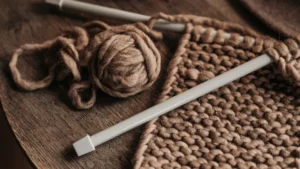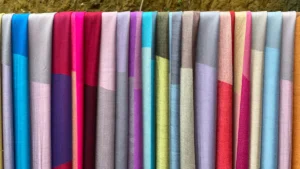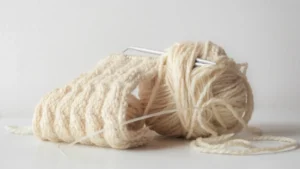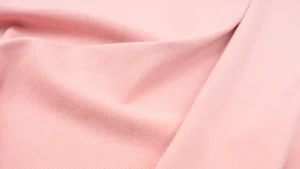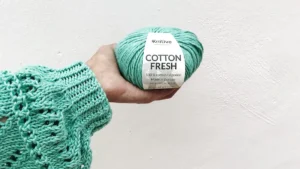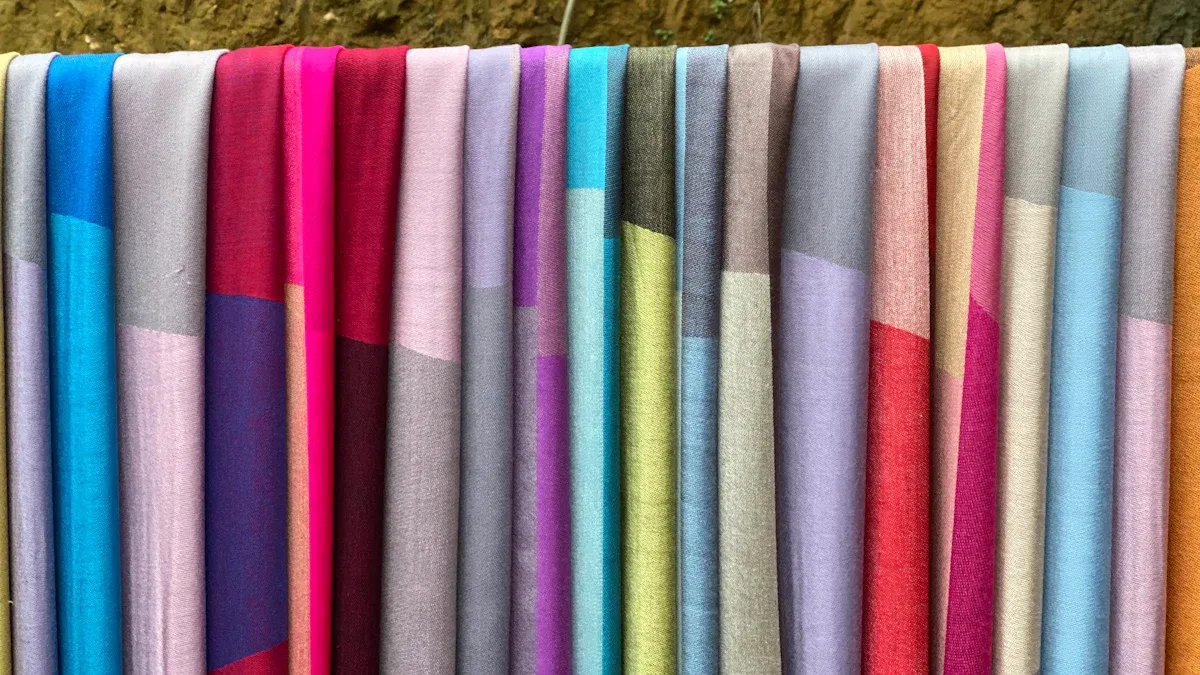
When deciding between knit vs woven fabrics, you change how your project feels and lasts. For example, a soft knit fabric is perfect for a comfy T-shirt, while a strong woven fabric works well for a durable tote bag. The difference between knit vs woven fabrics lies in comfort, style, and strength. Research shows that knit fabric types and fiber blends enhance moisture wicking and airflow, whereas woven fabric provides strong surface features. Understanding the knit vs woven distinction helps you create projects that look great, perform well, and stand the test of time.
Key Takeaways
Knit fabrics stretch easily, feel soft, and are great for comfortable, flexible clothing like T-shirts and activewear.
Woven fabrics are strong, keep their shape, and work well for durable items like jackets, bags, and home decor.
Choose knit fabric when you want comfort and stretch; pick woven fabric for structure and long-lasting strength.
You can tell knit from woven by looking for loops and stretch in knits, or a tight grid pattern and firmness in wovens.
Always check your project needs and fabric labels to pick the right fabric and avoid sewing problems.
Knit vs Woven Basics
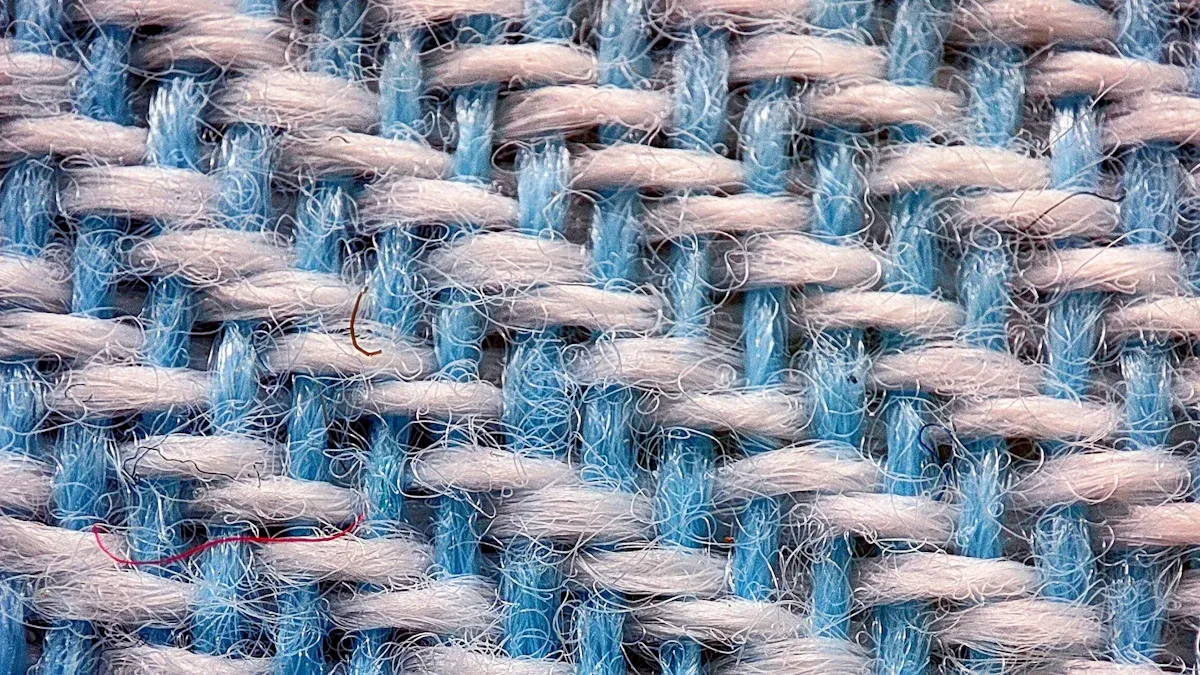
Construction
You can tell knit and woven fabrics apart by how they are made. Knit fabric is made by looping yarns together. These loops connect in rows. Needles are used for this, either by hand or machine. There are two main types of knitted fabrics. In weft knits, loops go from side to side. In warp knits, loops go up and down. Woven fabric is made differently. It uses two sets of yarns that cross at right angles. The yarns go over and under each other. This makes a grid pattern. Looms are used to make woven fabric. Woven fabric feels firm and does not stretch much. The way these fabrics are made is what makes them different.
Aspect | Knit Fabric | Woven Fabric |
|---|---|---|
Structure | Looped yarns (interlocking loops) | Interlaced yarns at right angles |
Stretch | Limited stretch | |
Texture | Soft and flexible | Stiff and structured |
Stretch and Structure
You notice the difference when you try to stretch the fabrics. Knit fabric stretches a lot because the loops open up. You can pull it in many ways, and it goes back to shape. Woven fabric does not stretch much unless it has elastic fibers. Its tight pattern keeps it firm and steady. Tests show knitted fabrics can stretch to twice their size. Woven fabrics stay almost the same size when pulled. This is why you pick knit for comfort and woven for structure.
Knitted fabrics are soft, let air through, and stretch easily.
Woven fabrics are strong, keep their shape, and do not stretch much.
Tip: Pick knit fabric if you want something that moves with you. Choose woven fabric if you need it to keep its shape.
Common Uses
You can see the difference in what these fabrics are used for. Knit fabric is used for T-shirts, sweaters, sports clothes, and pajamas. It feels soft and stretches with your body. Woven fabric is used for jeans, dress shirts, jackets, and things like curtains. The difference helps you choose the right fabric for your project.
Knit Fabric Type | Common Uses |
|---|---|
Sportswear, jogging suits | |
Jacquard | Sweaters |
Knitted Terry | Towels, bathrobes |
Woven Fabric Type | Common Uses |
|---|---|
Jeans, jackets | |
Chiffon | Dresses, scarves |
Corduroy | Pants, shirts |
When you know the basics of knit and woven, you can pick the best fabric for your project. The way these fabrics are made changes how they feel, last, and look.
Woven Fabrics
Key Features
You can tell woven fabrics by their strong, grid-like look. They are made by weaving two sets of threads together. The threads cross each other at right angles. This way of making fabric makes it sturdy and helps it keep its shape. Woven fabrics do not stretch much. This is different from knits. The way woven and knitted fabrics are made is not the same. This also changes how they act when you use them.
Woven fabrics are tough and do not wear out fast. There are many weave patterns you can find. Some are plain, twill, satin, basket, herringbone, jacquard, leno, and dobby. Each pattern gives the fabric a new look and feel. For example, twill weave makes lines that go sideways. Satin weave makes the fabric smooth and shiny. These patterns also change how strong and steady the fabric is.
Note: Woven fabrics let air pass through and come in many colors and designs. You can use them for projects that need to look nice and be strong.
Best Uses
Pick woven fabric when you need your project to last long. The tight weave helps things keep their shape after many washes or lots of use. Woven fabrics are good for jackets, shirts, skirts, and pants that need to be sturdy. You can also use them for home things like curtains and furniture covers. They do not stretch and keep their shape well.
Here is a table that shows where woven fabrics work best:
Project Type | Why Woven Fabrics Work Well |
|---|---|
Tailored Apparel | Keeps shape, looks crisp, lasts through wear and washing |
Home Decor | Holds up to daily use, resists stretching, offers many textures |
Industrial Uses | Provides strength for conveyor belts and protective covers |
Packaging | Stands up to heavy loads and rough handling |
Agriculture | Protects crops and soil, resists weather and pests |
You can also see woven fabric in sports clothes. Its strong weave lets you add special coatings for more strength or to keep water out. Experts say woven fabrics are best for things that need to be tough and hold their shape. If you want your project to last and look neat, choose woven fabrics.
Knitted Fabrics
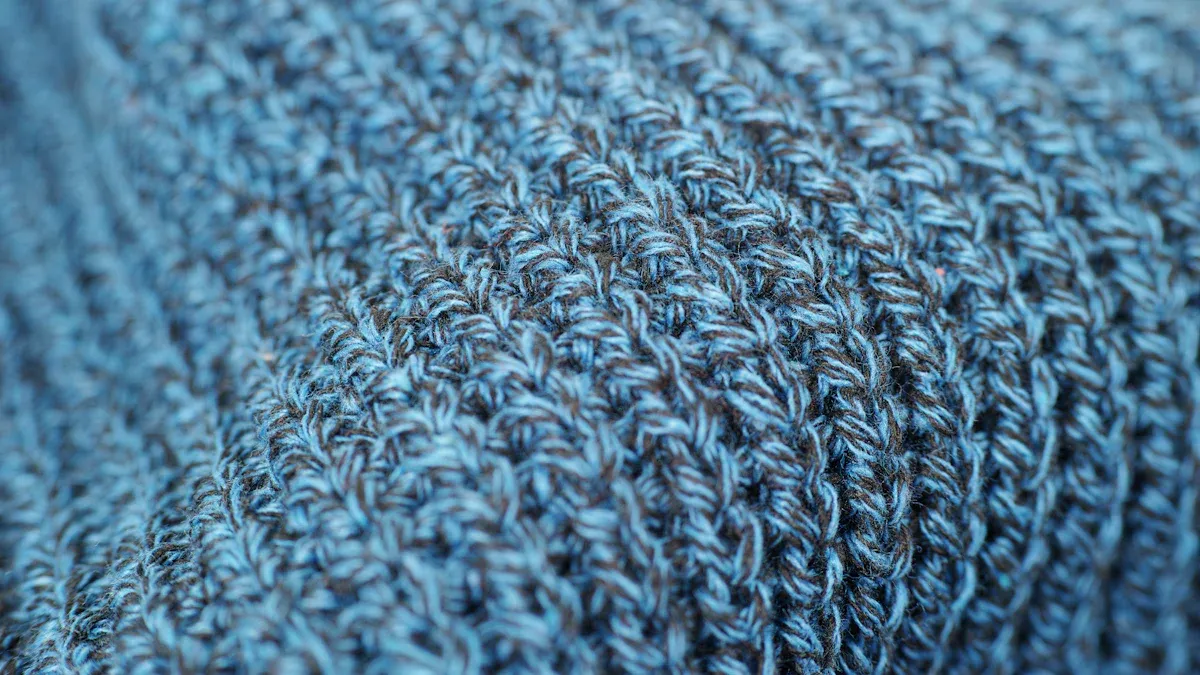
Key Features
You notice right away that knit fabric feels soft and flexible. This comes from the way the yarns loop together. The loops give knitted fabrics their famous stretch. You can pull knit fabric in many directions, and it bounces back to its shape. This stretch makes knit fabric comfortable for clothes you wear every day.
Here are some key features you will find in knitted fabrics:
Stretchability: Knit fabric stretches easily, so you can move freely. This makes it perfect for activewear and fitted clothing.
Softness: Many knitted fabrics use cotton, wool, or silk. These fibers feel gentle on your skin. Synthetic blends add even more durability.
Breathability: Knit fabric lets air pass through. You stay cool and dry, especially when you pick cotton knits.
Wrinkle Resistance: Knitted fabrics do not crease easily. You spend less time ironing.
Easy Care: Most knit fabric is simple to wash and dries quickly. The elastic structure helps it keep its shape.
Tip: If you want clothes that feel soft and move with you, choose knit fabric. You will enjoy the comfort all day.
Knitted fabrics come in many types. Jersey, rib knit, and interlock are popular choices. Each type offers a different level of stretch, thickness, and drape. You can find knit fabric made from cotton, bamboo, rayon, or blends with spandex for extra stretch.
Best Uses
You can use knitted fabrics for many projects. The stretch and comfort of knit fabric make it a top pick for clothing. You see knit fabric in T-shirts, leggings, and sweaters. Jersey knit fabric works well for soft T-shirts and dresses. Rib knit fabric is great for cuffs, necklines, and waistbands because it holds its shape.
Here are some common uses for knitted fabrics:
Activewear and sportswear: Knit fabric stretches and breathes, so you stay comfortable during exercise.
Casual wear: T-shirts, hoodies, and dresses use knit fabric for a relaxed fit.
Winter wear: Sweaters and scarves made from heavier knitted fabrics keep you warm.
Loungewear and sleepwear: Soft knit fabric feels cozy for pajamas and robes.
Baby clothing: Knitted fabrics are gentle and stretchy, perfect for infants.
Accessories: Hats, gloves, and socks use knit fabric for comfort and fit.
Home textiles: Blankets and cushion covers often use knitted fabrics for softness.
Knit Fabric Type | Best Uses |
|---|---|
Jersey | T-shirts, dresses, tops |
Rib Knit | Cuffs, neckbands, leggings |
Interlock | Sportswear, dresses, babywear |
Fleece | Hoodies, loungewear, blankets |
French Terry | Sweatshirts, activewear |
You can see how the unique features of knitted fabrics make them the right choice for projects that need stretch, comfort, and easy care. When you pick knit fabric, you get flexibility and style for many different needs.
Choosing for Your Project
Apparel
When you pick fabric for clothing, you need to think about how the garment will fit, feel, and move. Knit fabrics work best for clothes that need to stretch and fit close to your body. T-shirts, leggings, and sportswear use knit fabrics because they are soft, drapey, and breathable. These fabrics stretch in many directions, so you can move easily and stay comfortable all day.
Woven fabrics give structure and shape to your clothes. You see them in dress shirts, jackets, trousers, and skirts. These fabrics stretch only a little, mostly on the diagonal, and feel stiffer. If you want a crisp look or a formal style, choose woven fabrics. Patterns for clothing often tell you which fabric type to use. Using the wrong one can make your clothes fit poorly or feel uncomfortable.
Tip: Always check your sewing pattern. Patterns for knits have less extra space because the fabric stretches. Patterns for wovens add more room for comfort.
Here are some things to consider when choosing between knit and woven fabrics for apparel:
Knit fabrics are soft, stretchy, and comfortable.
Woven fabrics are structured, crisp, and hold their shape.
Knit fabrics work well for activewear, close-fitting dresses, and casual tops.
Woven fabrics suit tailored garments, blouses, and pants.
Sewing techniques and tools may change depending on the fabric type.
Home Decor
Home decor projects need fabrics that last and look good over time. Woven fabrics are the top choice for most home items. They offer strength, structure, and a wide range of textures. You find woven fabrics in curtains, upholstery, bedding, and tablecloths. Cotton, linen, and synthetic blends are popular because they are durable and easy to care for. Linen feels light and airy, while velvet adds a touch of luxury. Jacquard and sheer fabrics bring style and privacy to your windows.
Knit fabrics are less common in home decor, but you can use them for soft items like cushion covers, throws, or blankets. These fabrics feel cozy and stretch easily, but they may not hold their shape as well as wovens.
Note: Choose woven fabrics for projects that need to keep their shape, like upholstery or drapes. Woven fabrics resist sagging and wear, making them ideal for high-traffic areas.
Popular woven fabrics for home decor include:
Cotton: Versatile and comfortable for bedding and curtains.
Linen: Breathable and stylish for drapes and tablecloths.
Velvet: Soft and elegant for pillows and upholstery.
Synthetic blends: Durable and easy to clean for furniture covers.
Accessories
Accessories like bags, hats, and belts need fabrics that are strong and keep their shape. Woven fabrics work best for these projects. They resist stretching, hold up to daily use, and come in many colors and textures. You can easily clean and maintain them. Bags made from denim, canvas, or twill last a long time and do not sag.
Knit fabrics feel soft and flexible, but they may not be strong enough for structured accessories. You might use knit fabrics for soft hats, scarves, or stretchy headbands. However, for items that carry weight or need to look crisp, woven fabrics are the better choice.
Here are some pros and cons for each fabric type in accessories:
Woven fabrics: Durable, stable, easy to clean, and keep their shape. They may wrinkle and have limited stretch.
Knit fabrics: Soft, stretchy, and comfortable. They may curl at the edges and lack the strength needed for heavy use.
Tip: For sturdy bags and hats, always choose woven fabrics. For soft, flexible accessories, try knit fabrics.
Quick Checklist
Use this checklist to help you pick the right fabric for your next project:
Does your project need stretch and comfort?
Yes: Pick knit fabrics.
No: Pick woven fabrics.
Do you want a structured, crisp look?
Yes: Choose woven fabrics.
No: Knit fabrics work well for a relaxed style.
Is the item for heavy use or needs to hold weight?
Yes: Woven fabrics are best.
No: Knit fabrics can work for light use.
Are you making activewear or fitted clothing?
Yes: Knit fabrics provide stretch and comfort.
Are you making upholstery, curtains, or bags?
Yes: Woven fabrics offer strength and shape.
Do you need easy care and wrinkle resistance?
Woven fabrics may need ironing and gentle washing.
Remember: Always check the care label and pattern instructions before you start your project.
Project Type | Best Fabric Type | Why? |
|---|---|---|
T-shirt | Knit | Stretchy, soft, comfortable |
Dress Shirt | Woven | Structured, crisp, holds shape |
Leggings | Knit | Flexible, fits close to body |
Tote Bag | Woven | Durable, resists sagging |
Curtains | Woven | Strong, keeps shape, many textures |
Blanket | Knit | Soft, cozy, stretchy |
How to Identify Fabric Types
Visual and Touch Tests
You can learn how to tell knit from woven fabrics by looking closely and feeling the material. Woven fabrics show a clear grid pattern. You see straight lines crossing each other at right angles. The surface looks flat and feels firm. Woven fabrics do not have visible loops. They usually do not stretch much when you pull them.
Knit fabrics look different. You notice tiny V-shaped loops on the front. The back often shows small interlocking curves. Knit fabrics feel soft and stretchy. When you pull the edge, it curls up. This curling and stretchiness help you spot a knit fabric right away. Knit fabrics drape easily and move with your hand.
You can also use touch tests. Experts use special tools to measure softness, stretch, and how the fabric changes shape. These tests match what you feel with your hands. Knit fabrics feel elastic and smooth. Woven fabrics feel sturdy and less flexible. If you want to check at home, gently stretch the fabric. If it stretches in all directions and bounces back, it is likely a knit. If it feels stiff and only stretches a little on the diagonal, it is probably woven.
Tip: Look for loops and test the stretch. These clues help you choose the right fabric for your project.
Reading Labels
You can also check the label to learn about the fabric. Labels tell you if the fabric is knit or woven. They also list the fiber type, like cotton, polyester, or wool. Many people think cotton is always woven, but that is not true. Cotton can be knit or woven. T-shirts use cotton knit, while dress shirts use cotton woven. Always read the label and feel the fabric to be sure.
Some labels use words like “jersey,” “interlock,” or “rib.” These mean the fabric is knit. Words like “twill,” “sateen,” or “poplin” mean the fabric is woven. If you are not sure, ask a store worker or use the visual and touch tests.
Note: Labels give you important clues, but your eyes and hands help you make the final choice.
Choosing the right fabric type helps your project look better and last longer. If you pick the wrong fabric, you might face problems like:
Wavy seams in stretch fabrics
Sewing machine jams on tough fabrics
Thread breaking or fraying
Bunching at the start or end of seams
You can use the tips and checklist to avoid these issues. When you try both knit and woven fabrics, you learn new skills and discover how each fabric behaves. This hands-on practice builds your confidence and helps you create projects you feel proud of.
FAQ
What is the easiest way to tell if a fabric is knit or woven?
You can stretch the fabric gently. Knit fabric stretches easily in all directions. Woven fabric feels firm and only stretches a little on the diagonal. Look for loops in knits and a grid pattern in wovens.
Can you sew knit and woven fabrics with the same needle?
You should use a ballpoint or stretch needle for knits. This needle slides between loops without snagging. For woven fabrics, use a sharp or universal needle. This needle pierces the tight weave cleanly.
Is cotton always a woven fabric?
No, cotton can be either knit or woven. You find cotton knits in T-shirts and cotton wovens in dress shirts. Always check the fabric label or feel the fabric to know for sure.
Why does my knit fabric curl at the edges?
Knit fabric curls because of the way the loops pull on each other. This is normal. You can use pins or a pressing iron to help flatten the edges before sewing.
Which fabric lasts longer: knit or woven?
Fabric Type | Durability |
|---|---|
Knit | Good for light use, may stretch out over time |
Woven | Excellent for heavy use, keeps shape longer |
Woven fabrics usually last longer, especially for items that get lots of wear.



